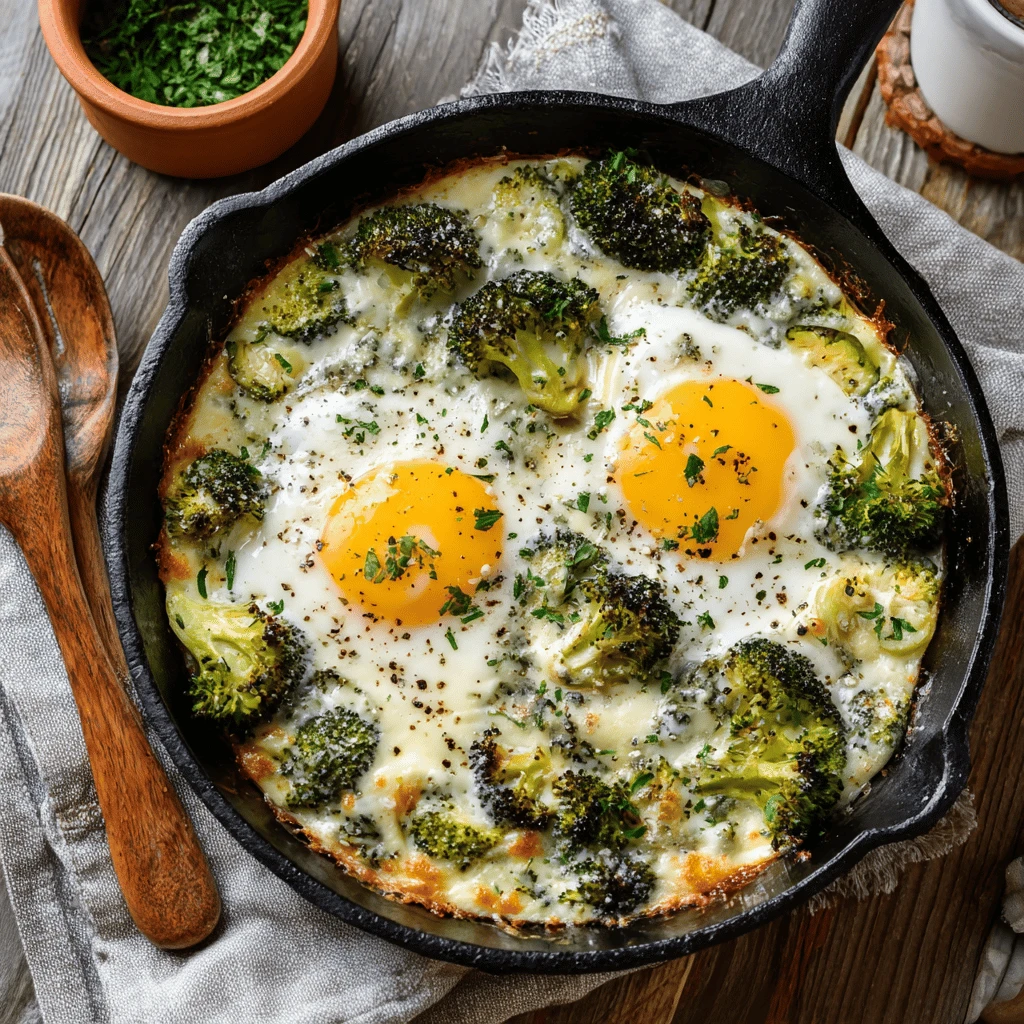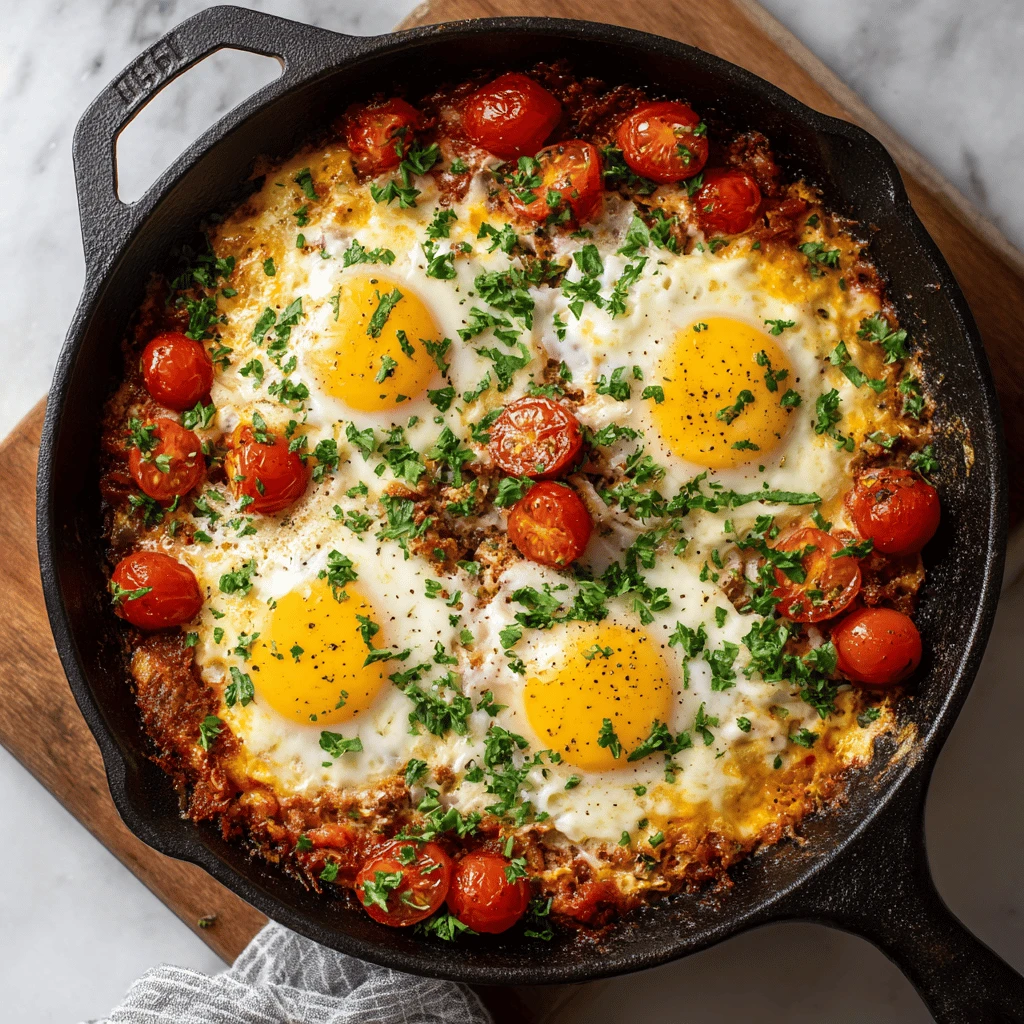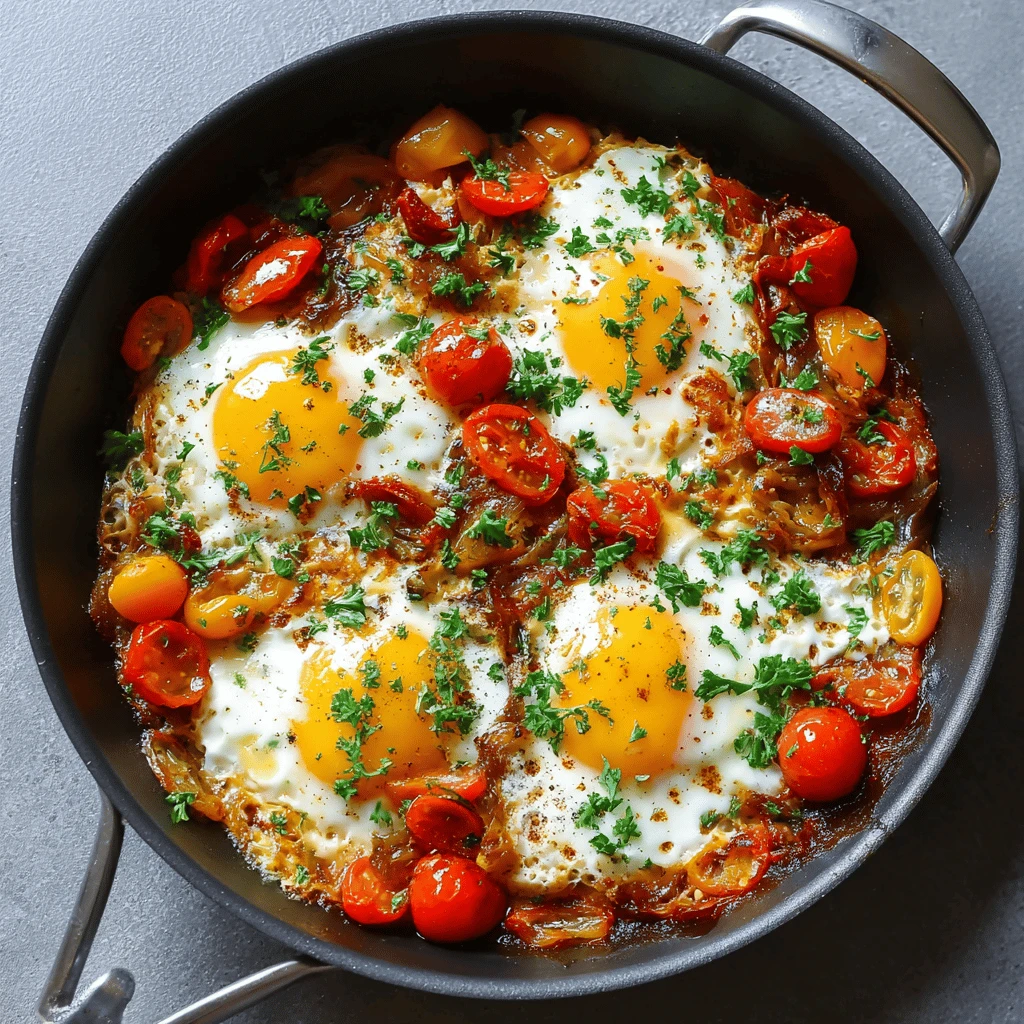Keto-Friendly Low Carb Eggs Skillet
Introduction: Your New Favorite Keto Breakfast (or Anytime)
The ketogenic diet, celebrated for its weight management and health benefits, emphasizes high-fat, low-carbohydrate foods. Finding quick, delicious, and compliant recipes can sometimes feel like a challenge. Enter the Keto-Friendly Low Carb Eggs Skillet – a versatile dish that’s not only incredibly simple to make but also packed with flavor and nutrients. Whether you’re a seasoned keto veteran or just starting out, this skillet is guaranteed to become a staple in your repertoire. It’s perfect for a hearty breakfast, a satisfying lunch, or even a light dinner.
Mastering the Basics: Ingredients and Preparation
The beauty of this skillet lies in its adaptability. While there’s a core set of ingredients, you can easily customize it to your liking based on your preferences and what you have on hand.
Core Ingredients:
- Eggs: The star of the show! They provide protein and healthy fats, crucial for keto.
- Low-Carb Vegetables: Spinach, bell peppers (especially green, as they are lower in carbs), onions, mushrooms, and zucchini are excellent choices.
- Cheese: Adds flavor and fat. Cheddar, mozzarella, Monterey Jack, or even cream cheese work wonderfully.
- Healthy Fats: Olive oil, coconut oil, or avocado oil for cooking.
- Protein (Optional): Bacon, sausage, ham, or cooked chicken can be added for extra protein and flavor. Make sure these meats are low in sugar and carbohydrate.
Preparation Steps:
1. Prep Your Veggies: Wash and chop all your chosen vegetables into bite-sized pieces. The smaller the pieces, the faster they will cook evenly.
2. Cook the Protein (If Using): If adding bacon or sausage, cook it until crispy in the skillet. Remove the cooked protein and set aside, leaving some of the rendered fat in the pan.
3. Sauté the Vegetables: In the same skillet with the rendered fat (or your chosen healthy oil), sauté the vegetables until they are tender-crisp. Start with onions and bell peppers, as they take longer to cook than spinach or mushrooms.
4. Add the Eggs: Whisk the eggs with a splash of cream or milk (almond milk or coconut milk for dairy-free). Pour the eggs over the sautéed vegetables.
5. Add Cheese and Protein: Sprinkle the cheese evenly over the eggs. If using, add the cooked protein back to the skillet.
6. Cook Until Set: Cook over medium heat until the eggs are mostly set but still slightly moist. You can cover the skillet with a lid to help the eggs cook more evenly.
7. Broil (Optional): For a golden-brown top, place the skillet under the broiler for a minute or two, watching carefully to prevent burning.
Flavor Variations: Elevate Your Skillet
The basic recipe provides a solid foundation, but don’t be afraid to experiment with different flavor combinations.
- Mediterranean: Add sun-dried tomatoes, olives, feta cheese, and a sprinkle of oregano.
- Mexican: Use chorizo, jalapenos, salsa, and cheddar cheese. Top with avocado.
- Italian: Add Italian sausage, mushrooms, bell peppers, mozzarella cheese, and a sprinkle of basil.
- Spicy: Incorporate diced chili peppers, hot sauce, and pepper jack cheese.
- Breakfast Sausage and Cheddar: Crumble your favorite breakfast sausage while cooking, and add it to the skillet. Top the whole concoction with plenty of sharp cheddar for a simple and satisfying keto breakfast.
- Creamy Spinach Artichoke: If you crave something a bit more decadent, stir in some cream cheese while the eggs are cooking to make this a rich, creamy dish. Mix in the spinach with artichoke hearts for a creamy and delicious keto delight.
Tips and Tricks for the Perfect Keto Skillet
- Use a Non-Stick Skillet: This will prevent the eggs from sticking and make cleanup a breeze. If you use stainless steel, be generous with the oil or cooking fat.
- Don’t Overcook the Eggs: Overcooked eggs can become rubbery. Cook until they are just set.
- Pre-Cook Ingredients: If using vegetables that take longer to cook, like potatoes or broccoli, pre-cook them before adding them to the skillet. Note that those ingredients are not low-carb options.
- Season Generously: Season the vegetables and eggs with salt, pepper, and any other spices you enjoy.
- Use Quality Ingredients: The better the quality of your ingredients, the better the flavor of your skillet.
- Make it Ahead: Cook the vegetables and protein ahead of time and store them in the refrigerator. When you’re ready to make the skillet, simply add the eggs and cheese. This can be a great time saver during the week.
- Consider portioning the dish into meal prep containers: This makes it easy to grab and go when you’re short on time.
Keto Beyond Breakfast: Expanding the Skillet’s Role
While the Keto-Friendly Low Carb Eggs Skillet shines as a breakfast option, its versatility extends far beyond the morning meal.
- Lunch Power-Up: This skillet provides a substantial and nutritious lunch that will keep you full and energized throughout the afternoon. Pair it with a side salad for a complete meal.
- Quick and Easy Dinner: On busy weeknights, the skillet can be a lifesaver. It comes together quickly and requires minimal cleanup. Add a side of steamed vegetables or a keto-friendly salad to complete the meal.
- Party Appetizer: Cut the skillet into small squares and serve as an appetizer at your next gathering. The colorful vegetables and cheesy goodness will be a hit with guests.
- Post-Workout Recovery: The protein and healthy fats in the skillet make it an excellent choice for post-workout recovery. It will help replenish your energy stores and repair muscle tissue.
- Brunch Staple: Wow your guests at your next brunch with this delicious and customizable skillet. Set up a topping bar with different cheeses, vegetables, and proteins so everyone can create their own masterpiece.
Frequently Asked Questions (FAQ)
-
- Is this skillet really keto-friendly?
Yes, as long as you use low-carbohydrate vegetables and avoid ingredients like potatoes, corn, or excessive amounts of carrots. Focus on leafy greens, peppers, onions, and non-starchy vegetables.
-
- Can I make this skillet dairy-free?
Absolutely! Substitute coconut oil or avocado oil for butter, and use dairy-free cheese alternatives like cashew cheese or nutritional yeast. Use almond milk or coconut milk when whisking the eggs.
-
- How long does this skillet last in the refrigerator?
Cooked skillet can be stored in the refrigerator for up to 3-4 days. Reheat thoroughly before serving.
-
- Can I freeze this skillet?
While it's best enjoyed fresh, you can freeze the skillet in individual portions for up to 2 months. Thaw overnight in the refrigerator and reheat thoroughly. The texture of the eggs may change slightly after freezing.
-
- What are some other vegetables I can add?
Broccoli, cauliflower, asparagus, and green beans are all great low-carb additions.
-
- How can I make this spicier?
Add diced jalapenos, a dash of hot sauce, or a pinch of red pepper flakes to the skillet. You can also use spicy sausage or chorizo.
-
- Can I use liquid egg whites instead of whole eggs?
Yes, you can, but the skillet will be lower in fat. You may want to add some extra healthy fats, such as avocado or coconut oil, to compensate.
-
- What kind of cheese works best?
Cheddar, mozzarella, Monterey Jack, and cream cheese are all excellent choices. Use whatever cheese you prefer and that fits your keto macros.
- Is it important to use a cast-iron skillet?
Using a cast-iron skillet is not mandatory but is highly recommended. Cast iron distributes heat evenly, making it ideal for cooking a skillet evenly.
- Are there any ingredients to avoid on keto?
You should avoid starchy vegetables like potatoes and corn, sugary sauces, and high-carbohydrate grains when following a ketogenic eating plan.




